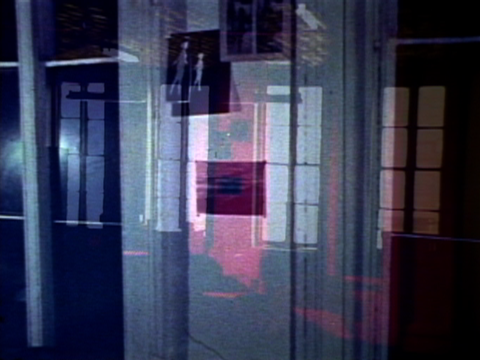One week in December 1966, Canadian visual artist, jazz musician, and experimental filmmaker Michael Snow (b. 1928) produced Wavelength, which is widely regarded as a classic and one of the most discussed examples of avant-garde filmmaking. The film is a continuous zoom from a fixed camera, which takes 45 minutes to go from its widest field—the floor, walls, and windows of an empty loft—to its smallest, final field—a photograph of ocean waves pinned to a wall 80 feet away. As the camera slowly narrows in, a woman enters the space with two men carrying a cabinet. She returns with a friend to drink and listen to a radio playing the Beatles’ “Strawberry Fields Forever.” Much later, glass shatters offscreen, and a man enters and inexplicably collapses onto the floor. When the woman returns, she finds his body and makes an emergency phone call. Throughout Wavelength, an electronic sound, a slowly rising sinewave, plays over the action.
Although human activity occurs within the camera’s frame, it is not the focus. The center of the work is no longer the image, but the relationship between the image and the viewer. In the 1960s and 70s, young artists began to turn away from the more complex, chaotic forms of cinema developed by Maya Deren, Stan Brakhage, and others. They instead opted to create “structural films” that concentrate on the mechanics of filmmaking with minimalist style and four main characteristics: “fixed camera position . . . the flicker effect, loopprinting, and rephotography off the screen.” The simplicity and directness of their approaches disallows the usual escapism of storytelling or signification of visual elements. Rather than narratives and symbolism, viewers observe pure space and time of film.
Snow would go on to produce new works incorporating elements of or inspired by Wavelength. In 1969–71, he created Slidelength, a slide installation incorporating film stills and color filters from the original production. In 2019, he made Wavelength for the Tate Modern, an audio performance that reworks the film’s sinewave soundtrack into a new composition distributed across multiple channels of sound in real time. By 2003, Snow developed an interest in digital media that led to the masterful manipulation WVLNT (Wavelength for Those Who Don’t Have the Time), 1966–67/2003, a clever condensation of Wavelength, in which Snow folds the film into and over itself.
Snow divided the original film into three equal, 15-minute lengths and superimposed them so the first, middle, and last scenes of Wavelength overlap. In this compressed format, the sequences of events are out of order and the waves of the photograph appear at three different scales as does the tone of the sinewave soundtrack. Interestingly, the new work shows how much variation of light and color occurs over time in the original film, as WVLNT continually and intermittently shifts through red, blues, pinks, and purples. The layered, fluctuating, pulsing, trancelike imagery of WVLNT perhaps is more illustrative of Snow’s initial concerns when making Wavelength, as he stated, “I wanted to make a summation of my nervous system, religious inklings, and aesthetic ideas . . . in which the beauty and sadness of equivalence would be celebrated.”
—Kanitra Fletcher

